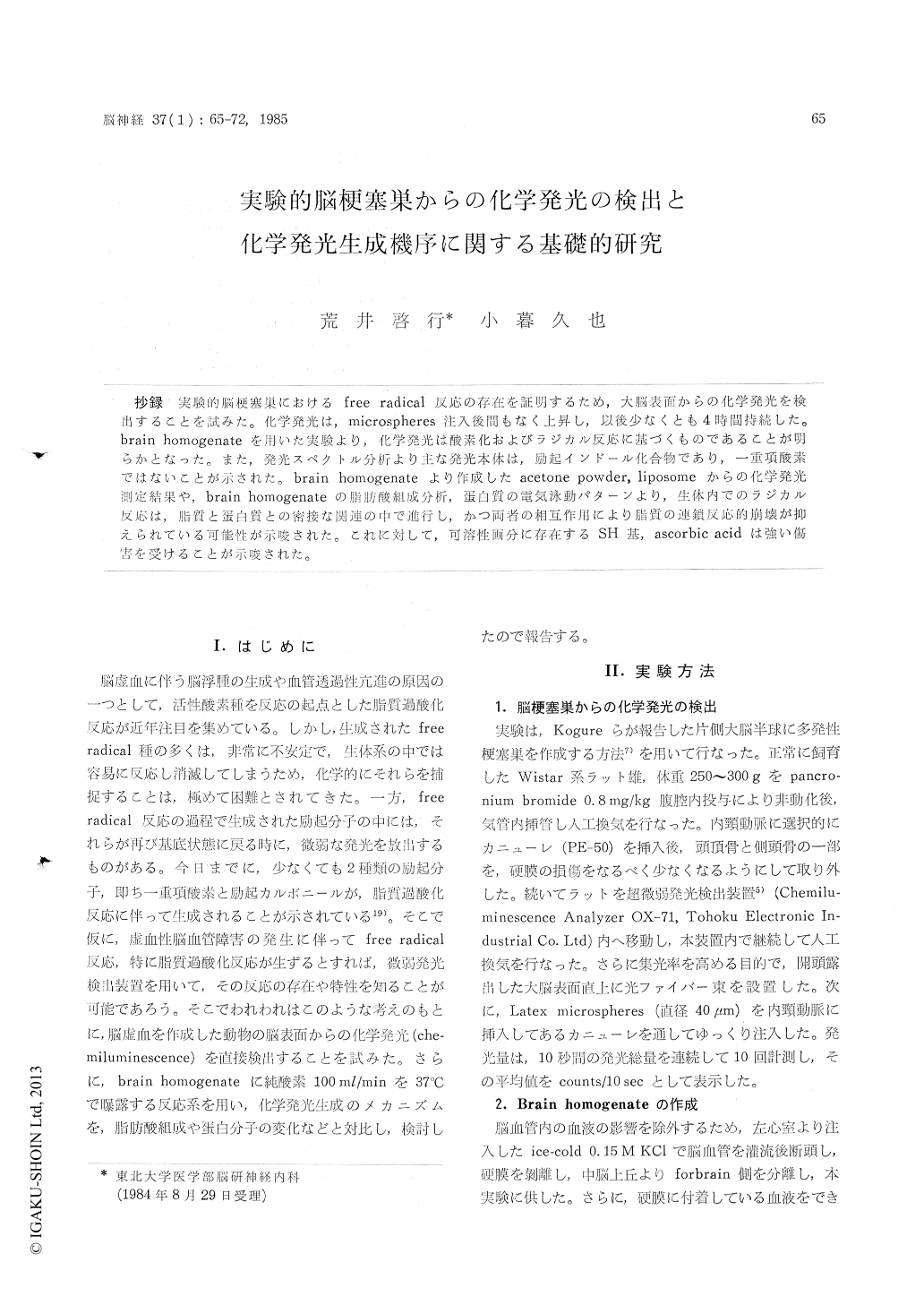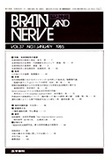Japanese
English
- 有料閲覧
- Abstract 文献概要
- 1ページ目 Look Inside
抄録 実験的脳梗塞巣におけるfree radical反応の存在を証明するため,大脳表面からの化学発光を検出することを試みた。化学発光は,microspheres注入後間もなく上昇し,以後少なくとも4時間持続した。brain homogenateを用いた実験より,化学発光は酸素化およびラジカル反応に基づくものであることが明らかとなった。また,発光スペクトル分析より主な発光本体は,励起インドール化合物であり,一重項酸素ではないことが示された。brain homogenateより作成したacetone powder,liposomeからの化学発光測定結果や,brain homogenateの脂肪酸組成分析,蛋白質の電気泳動パターンより,生体内でのラジカル反応は,脂質と蛋白質との密接な関連の中で進行し,かつ両者の相互作用により脂質の連鎖反応的崩壊が抑えられている可能性が示唆された。これに対して,可溶性画分に存在するSH基,ascorbic acidは強い傷害を受けることが示唆された。
Chemilunescence measurement in vivo system and its related studies on free radical reaction were reported. Weak chemiluminescence from rat brain surface subjected to ischemic cerebral stroke could be detected. It was observed just after embo-lization and lasted at least four hours. In order to investigate the mechanism of the generation of chemiluminescence and a side reaction of lipid peroxidation, several studies were made using 10% brain homogenate under oxygenated conditions at 37℃. Brain homogenate showed increasing chemi-luminescence that reached a plateau level a few hours later. Chemilunescence, accompanying with thiobarbituric acid reactive substance (TBARS) formation, was based on free radical reaction with requirement of oxygen. Time course increase in TBARS formation, however, revealed some diffe-rences from that of integrated light intensity. Chemiluminescence spectrum in the visible region showed that excited indole chemicals (triplet sta-tes) generated in the present system emitted light during their return to ground state, but not sing-let molecular oxygen. Suspension of acetone pow-der inTris-HC1 buffer prepared from brain homo-genate also disclosed chemiluminescence to some extent, whereas liposomes made of extracted brain lipid did not. These results probably indicate that proteins are essential for luminescence, but not lipid only, and involves the lipid-protein inter-action in oxygenated brain homogenate. In the pro-cess of lipid-protein interaction, neither fatty acids composition nor protein molecules significantly altered, except for a newly-appeared high mole-cular weight protein. On the other hand, SH group was suggested to be quite vulnerable to free radical attack. Ascorbate (10-5-10-2 M) show-ed either enhancing or suppressing effect on che-miluminescence and TBARS formation, depending on its concentration. NADPH (2 mM) enhanced chemiluminescence from brain homogenate to great extent and that from suspension of acetone pow-der to some extent, indicating the importance of the other cofactors as well as NADPH dependent cytochrome C reductase. Both chemiluminescence from suspension of acetone powder and that from liposomes were enhanced by free Fe2+. These results give an idea that chemiluminescence de-pends on mixed function of autoxidation and enzymatic reduction of iron-chelate. Direct evi-dence of the formation of some free radical spe-cies could be obtained by ESR spectrometry. At the disappearance of the signal of ascorbate free radical on ESR spectrogram showed good correla-tion to the decrease in ascorbate content. Finally, it must be stressed that tryptophan residue would be excited to high energy state in protein rich system as tissue homogenate. It is not singlet mo-lecular oxygen that emitts photons, but excited indole chemicals. It seems likely that chemilumi-nescence from brain homogenate strongly reflects the reaction between lipid and protein.

Copyright © 1985, Igaku-Shoin Ltd. All rights reserved.


